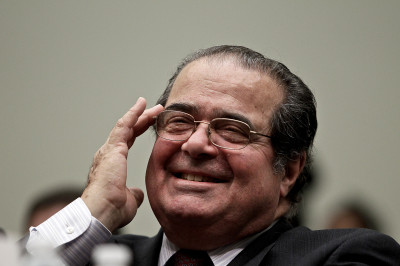MATS Rules Declared Invalid in Michigan v. EPA, 5-4
Opinion by Scalia Based on Meaning of “Appropriate”
 The U.S. Supreme Court today struck down EPA’s rules governing toxic emissions from power plants. My first take on the opinion, by Justice Scalia, is that while the outcome is bad for the agency, the reasoning appears not to be a radical departure from existing doctrine, with one worrisome tidbit thrown in. Justice Scalia used the traditional two-step Chevron doctrine to hold that EPA should have used cost to determine whether to regulate power plant toxic emissions in the first place. He did not stray from that traditional formula, simply disagreeing with a vigorous dissent from Justice Kagan about how to apply the Chevron doctrine. The opinion is also somewhat ironic in that Scalia, in determining whether EPA’s interpretation of the Clean Air Act was reasonable, relied on the context of the statute, something seemingly lacking in his dissent in the Obamacare case.
The U.S. Supreme Court today struck down EPA’s rules governing toxic emissions from power plants. My first take on the opinion, by Justice Scalia, is that while the outcome is bad for the agency, the reasoning appears not to be a radical departure from existing doctrine, with one worrisome tidbit thrown in. Justice Scalia used the traditional two-step Chevron doctrine to hold that EPA should have used cost to determine whether to regulate power plant toxic emissions in the first place. He did not stray from that traditional formula, simply disagreeing with a vigorous dissent from Justice Kagan about how to apply the Chevron doctrine. The opinion is also somewhat ironic in that Scalia, in determining whether EPA’s interpretation of the Clean Air Act was reasonable, relied on the context of the statute, something seemingly lacking in his dissent in the Obamacare case.
The background on Michigan v. EPA is here. In general administrative law terms, here is what was at stake in today’s case: EPA was required under the Clean Air Act to decide whether it was “appropriate and necessary” to regulate toxic emissions from power plants. EPA had to decide what the phrase “appropriate and necessary” meant. The agency decided that the phrase did not include the costs associated with regulating the emissions. Instead, EPA reasoned, once it decided whether to regulate the emissions, it would take costs into account in actually setting the standards to be applied to power plants to reduce their emissions. The Court had to decide whether the agency’s interpretation of the phrase “appropriate and necessary” was correct. In doing so it applied a standard of review set forth in the case Chevron v NRDC. The standard asks two questions: first, is the phrase at issue “unambiguous.” The Court assumed without even discussing the issue that “appropriate and necessary” is ambiguous and thus moved directly to Chevron Step 2. To apply Chevron Step 2 the Court asks whether the agency’s interpretation of the disputed phrase is a reasonable one. So was it reasonable for EPA to interpret “appropriate and necessary” to exclude the consideration of costs? Justice Scalia said no, it was not reasonable. In particular, he said, “appropriate” is a capacious word that should include cost. He uses most of the opinion to explain why it is unreasonable not to consider cost in determining whether to regulate under the “appropriate and necessary” standard, including because the context of the statute suggests cost should be included. Justice Kagan uses most of her dissent to criticize the majority for failing to consider the entire context of the regulatory process, where EPA explicitly takes cost into account once it is setting the standards power plants must meet to comply with the toxics rules (called the MATS rule). So the debate between them is really in some respects a garden variety Chevron debate about whether the agency is interpreting the statute reasonably. The case will be another example for administrative law scholars to use in arguing about what “reasonable” is supposed to mean and about how deferential the Court is to agency interpretations. Scalia’s opinion is clearly less deferential to the agency’s reasoning than Justice Kagan’s. But, again, it is not a departure from standard administrative law disputes. In this respect Michigan v. EPA is much less dramatic than the Court’s Obamacare opinion in King v. Burwell, in which Justice Roberts refused to defer to the IRS interpretation of whether subsidies apply to state health care exchanges and said that the Court must interpret the phrase itself given the political and economic import of the question the Court faced.
Here is the one worrisome tidbit in today’s majority opinion in Michigan. EPA did a cost-benefit analysis of the toxics air rules in evaluating the standards it adopted. The agency found that the benefits of the rule outweighed the costs by tens of billions of dollars. EPA found the costs to industry in complying with the rule to be $9.6 billion. It found the benefits to be between $33 and $90 billion. Many of these benefits come from what are known as “co-benefits,” benefits that come from reductions in pollutants other than the toxics actually being regulated from the installation of control technology. Controlling mercury and other toxic pollutants will also lead to reductions in fine particulate matter and these particulate reductions produce especially large health benefits through reduced respiratory, cardiac and other health harms. Justice Scalia was highly dismissive of these co-benefits, characterizing the rule instead as producing $9.6 billion in costs and just $4-6 million in benefits excluding the “ancillary” benefits. Indeed he left open the question whether these ancillary benefits can be used on remand when the agency must factor cost into account when deciding whether it is “appropriate and necessary” to regulate power plant toxic emissions. If EPA cannot use these ancillary benefits — something it routinely does — the agency may have a hard time justifying the MATS regulations. On the other had, the rule’s cost-benefit analysis also did not quantify a number of benefits the rule would produce from the reduction in toxic exposure, including a reduction in cardiovascular and neurological and genotoxic effects. We may see the agency attempt to quantify those benefits as a new rule making moves forward. On the brighter side, Justice Scalia also said that EPA need not conduct a “formal cost-benefit analysis in which each advantage and disadvantage is assigned a monetary value. It will be up to the Agency to decide (as always, within the limits of reasonable interpretation) how to account for cost.” So that language suggests, as well, that EPA will be given deference in how it accounts for cost in deciding whether power plan regulations for toxic emission are “appropriate and necessary.” I would expect EPA to re-issue the rules once it complies with the Court decision.
Another important thing to note is that the substantive effect of today’s ruling may actually not be that significant. The date for complying with the air toxics rule has already passed and a significant number of power plants have already complied with it. Several large power companies, including American Electric Power, Southern Company and First Energy, have already said that a Court decision tossing out the MATS rule would not affect their decision making. A number of coal-fired power plants are being taking off line in response to a numerous other factors, including the low price of natural gas and the cost of complying with other air pollution rules like the Cross State Air Pollution rule upheld in EPA v. EME Homer City Moreover the case will be remanded to the D.C. Circuit Court of Appeals to a panel that upheld the rule 2-1. It is quite possible that the panel will leave the rule in effect pending EPA’s complying with the directive to take costs into account in deciding on whether to regulate, especially given that the agency has already conducted an extensive cost-benefit analysis.
Finally, it’s worth addressing what, if anything, Michigan v. EPA says about the legality of the President’s proposed Clean Power Plan to regulate greenhouse gas emissions from power plants. As I said in a previous post,
My own view is that, as with many environmental cases, whatever the Court rules in Michigan is likely to tell us very little about the legality of the Clean Power Plan because the cases are so bound up with very specific and separate statutory provisions that contain different language and are thus subject to very different interpretation. In fact if EPA loses in the Michigan case, it will be the first anti-environmental ruling in the four Clean Air Act cases that the Court has considered since 2007 when it decided the landmark Massachusetts v. EPA. Thus the three cases upholding aggressive environmental regulation under the Clean Air Act — Mass v. EPA (finding that greenhouse gases are pollutants under the Clean Air Act and ordering EPA to consider regulating them from cars); Utility Air Regulatory Group v. EPA (largely upholding the agency’s rules governing emissions from new facilities); and EPA v. EME Homer City Generation,(upholding rules governing air pollution that crosses state borders) — will have meant little in the outcome of the Michigan case. The Clean Power Plan will rise or fall based on statutory language included in a section of the Clean Air Act, Section 111d, that the Court simply hasn’t considered before. Michigan v. EPA, in other words, will tell us very little about what the Court thinks Section 111d means in deciding whether the Clean Power Plan is legal.
I stand by that view. The Michigan case interpreted a phrase, “appropriate and necessary,” that is unique to the question of whether and how EPA should regulate toxic emissions from power plants. It has nothing to do with whether and how EPA should regulate greenhouse gas emissions from power plants. The second question will turn on different statutory language — phrases like “best system of emissions reduction,” “standards of performance” and “sources” — and how EPA interprets that language. So today’s case tells us very little about what will happen when the Clean Power Plan comes before the Court. Again, however, one ironic exception. Industry is challenging the Clean Power Plan on the grounds that if power plants are regulated under the hazardous air/toxics provision, Section 112, then EPA cannot regulate greenhouse gas emissions under Section 111d. If the MATS rules were not to go forward then presumably industry would drop the portion of its challenge dealing with Section 112. Hard to imagine that the MATS rules would not go forward, however.






Reader Comments